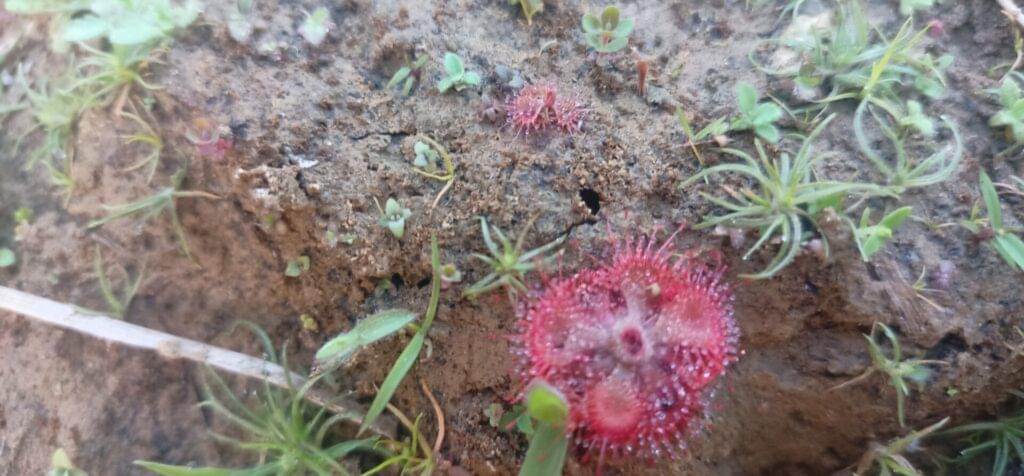
Introduction:
In the intriguing world of carnivorous plants, Drosera Burmannii emerges as a petite yet remarkable specimen, renowned for its rapid trapping reflexes and captivating allure. This annual variety of Drosera, commonly found in paddy fields and damp habitats after the monsoon, graces enthusiasts with its compact size and swift predatory tactics. Join us as we explore the wonders of Drosera Burmannii, from its taxonomy and natural habitat to its unique propagation and self-fertile flowers.
Taxonomy and Natural Habitat:
Drosera Burmannii, a member of the Drosera genus within the Droseraceae family, finds its natural habitat in the paddy fields and damp areas of Asia, particularly thriving after the monsoon season. From the humid landscapes of India to the marshy regions of Sri Lanka, this carnivorous plant adapts to moist environments where it can prey on unsuspecting insects.
Physical Structure and Lifespan:
Characterized by slender stems and rosettes of tiny leaves adorned with sticky glandular hairs, Drosera Burmannii exhibits lightning-fast reflexes when capturing prey, earning it the reputation as one of the fastest curling carnivorous plants. In cultivation, Drosera Burmannii typically lives for around 3 to 4 months, occasionally enduring up to a year under optimal conditions. With its short lifespan, this sundew relies solely on seed propagation for reproduction, lacking the ability to propagate through division or leaf cutting.
Cultivation:
Successfully cultivating Drosera Burmannii requires replicating its natural habitat’s environmental conditions. A well-draining substrate, such as a mixture of peat moss and perlite, provides a suitable medium for root development. Placing the plant in bright, indirect light stimulates vigorous growth and photosynthesis. Watering with distilled or rainwater prevents mineral buildup and maintains soil moisture levels essential for healthy development. Thriving in temperatures ranging between 70-85°F (21-29°C), Drosera Burmannii flourishes under warm conditions.
Pest Control:
Despite its carnivorous nature, Drosera Burmannii may encounter pests such as aphids or spider mites. Swift action is crucial in managing infestations, with gentle removal or the application of insecticidal soap effectively controlling pests. Maintaining a clean growing environment minimizes the risk of infestations and ensures the plant’s continued health and vitality.
Propagation:
Lorem ipsum dolor sit amet, consectetur adipiscing elit. Ut elit tellus, luctus nec ullamcorper mattis, pulvinar dapibus leo.
Add Your Heading Text Here
Propagation of Drosera Burmannii solely relies on seed propagation due to its short lifespan and inability to propagate through division or leaf cutting. The self-fertile flowers of Drosera Burmannii eliminate the need for external pollinators, allowing the plant to produce viable seeds independently. Collecting seeds from mature specimens and sowing them on moist soil provides the primary method for propagating this captivating sundew.
Frequently Asked Questions(FAQs):
1. What is Drosera Burmannii?
Drosera Burmannii is a species of carnivorous plant commonly known as the Asian sundew. It belongs to the Drosera genus and is renowned for its small size, sticky glandular hairs, and rapid trapping reflexes.
2. Where does Drosera Burmannii originate from?
Drosera Burmannii is native to tropical and subtropical regions of Asia, including countries like India, Sri Lanka, and Thailand. It thrives in damp, marshy habitats such as paddy fields and wetlands.
3. How big does Drosera Burmannii grow?
Drosera Burmannii typically remains relatively small, with rosettes of leaves reaching around 1-3 centimeters in diameter. It is considered one of the smaller species within the Drosera genus.
4. What is the lifespan of Drosera Burmannii?
In cultivation, Drosera Burmannii typically lives for around 3 to 4 months, although it can occasionally survive for up to a year under optimal conditions.
5. How does Drosera Burmannii trap its prey?
Drosera Burmannii captures prey using its sticky glandular hairs, which exude a mucilaginous substance. When an insect lands on the leaves, it becomes trapped by the sticky secretion, after which the plant slowly engulfs and digests its prey.
6. What are the ideal growing conditions for Drosera Burmannii?
Drosera Burmannii thrives in bright, indirect light and requires consistently moist soil. It prefers temperatures between 70-85°F (21-29°C) and benefits from high humidity levels. A well-draining substrate, such as a mix of peat moss and perlite, is recommended for cultivation.
7. How should Drosera Burmannii be watered?
Watering Drosera Burmannii with distilled or rainwater is recommended to prevent mineral buildup in the soil. It is essential to keep the soil consistently moist but not waterlogged to avoid root rot.
8. Can Drosera Burmannii be propagated?
Yes, Drosera Burmannii can be propagated through seed propagation. However, it does not propagate through division or leaf cutting due to its short lifespan and unique growth habits.
9. Does Drosera Burmannii require pollination?
Drosera Burmannii flowers are self-fertile, meaning they do not require external pollinators for seed production. The plant is capable of self-pollination, allowing it to produce viable seeds independently.
10. How can pests be managed on Drosera Burmannii?
While Drosera Burmannii is relatively resistant to pests, occasional infestations of aphids or spider mites may occur. Pest management can be achieved through gentle removal by hand or the application of insecticidal soap, ensuring a clean growing environment to minimize the risk of infestations.


